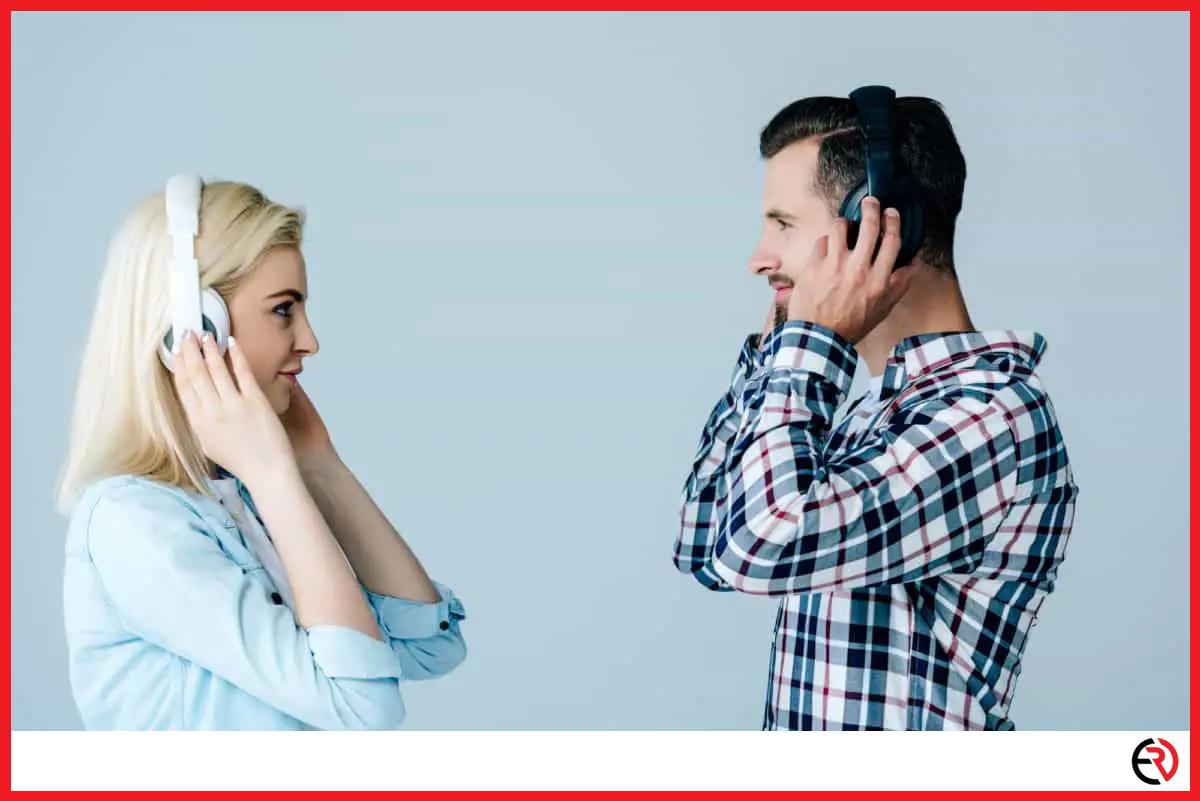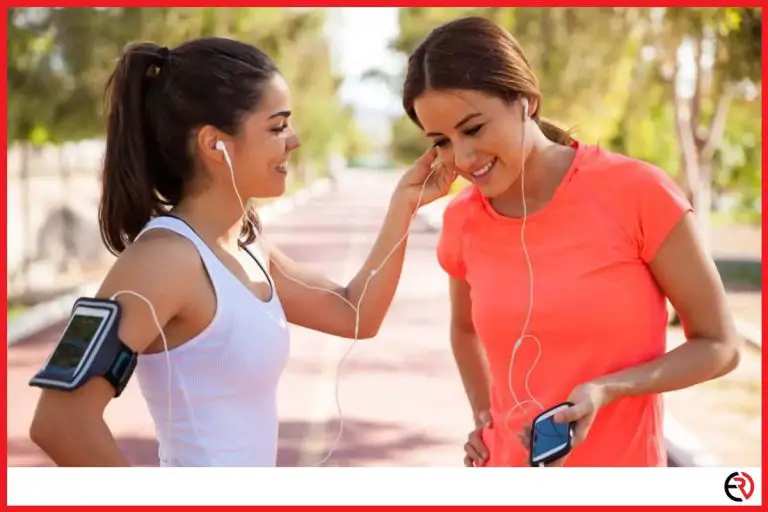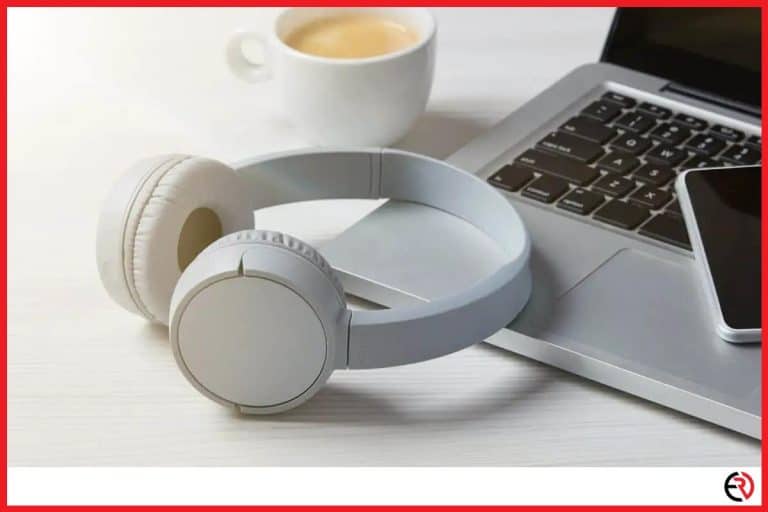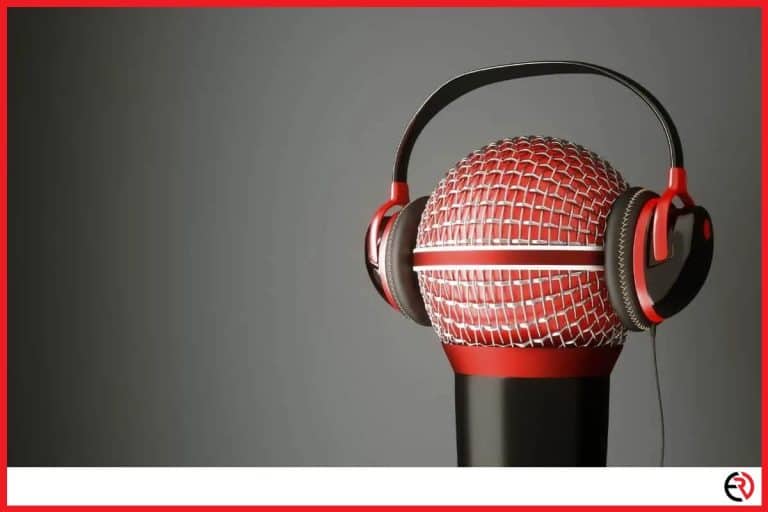Here’s Exactly How Headphones Should Fit: A 3-Part Guide
This post may contain affiliate links which means that, if you choose to make a purchase, I may earn a small commission at no extra cost to you.
If you frequently use headphones or are considering investing in a new pair, the fit is one of the most important things to consider. You can have the best-sounding headphones in the world, but if they aren’t comfortable, you’re not going to be happy.
So, how exactly should headphones fit?
Headphones should fit tight and snug, staying in place despite excessive movement. Headphones with the right fit will remain comfortable for more than 20 minutes.
Getting your headphones to fit perfectly involves the following:
- Choose the right pair of headphones
- Wear the headphones properly
- Adjust as needed to add more comfort
Below, we are going to go into depth regarding how you can find the right pair of headphones, how to wear them properly, and some options you have for adding additional comfort. Read on to find out exactly how headphones should fit.
Choosing Headphones
The first step in getting headphones to fit perfectly is, well, having headphones! If you already have a pair of headphones, then feel free to jump to the next section, where we will discuss the correct way to wear headphones.
Choosing a pair of headphones involves the following:
#1 – Choose the kind of headphones you want based on your needs. While there are many different kinds of headphones, we will go over the three main types:
- Over-Ear Headphones
- On-Ear Headphones
- In-Ear Headphones
#2 – Consider the essential components of headphones that determine comfort:
- Clamping Force
- The Headband
- Ear Cup Extension
- Ear Cup Rotation
- Ear Cup Size
- Ear Cup Depth
- Cushioning
#3 – Select a pair that is the right size, has a comfortable material, and has all the features you are looking for
Below, we will go over each of these three steps in more detail.
Different Kinds of Headphones: Which is Best for you?
Over-Ear Headphones
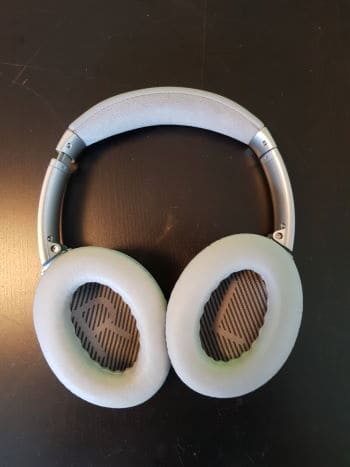
Over-Ear headphones are headphones that fit on top of your head and in which the entirety of your ear, including all ear cartilage, fits inside the earcups.
This style is best for sound isolation and noise-cancellation, as it keeps the sound, you are listening to in and keeps out all ambient noise from your environment, offering extremely high-quality sound capabilities.
Most of these kinds of headphones are very comfortable and offer the best sound quality and sound isolation. However, some cons to consider are that this is one of the biggest/bulkiest options, there is little air-circulation, so you might sweat after extended periods of time, and they are on the heavier side, so it might cause some fatigue after a while.
Overall these headphones are best for if your goal is to completely shut out the outside world and enjoy pristine, crisp audio with headphones that are super comfortable, albeit large and bulky, such as when gaming or listening to music or podcasts.
On-Ear Headphones
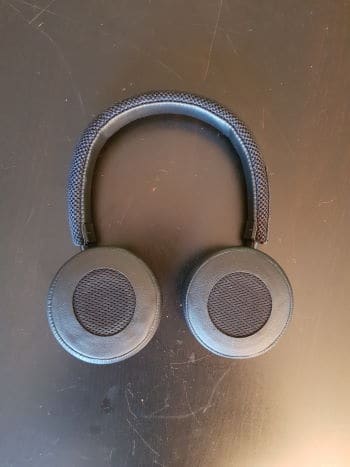
On-Ear headphones are headphones that rest on top of your ears. These kinds of headphones are generally going to closer to the size of your actual ears, so quite a bit smaller than over-ear headphones.
On-ear headphones, unlike over-ear headphones, allow some sound to exit and enter through the headphones, so these are not the best if your goal is sound isolation.
On-ear headphones are usually fairly light and allow enough circulation to prevent sweating. Since these headphones will be resting on your ears, it’s important to make sure they do not apply too much pressure, which can begin to cause pain over time.
Many on-ear models offer both great sound quality and comfort. These kinds of headphones are very versatile and can be used for purposes that require either in-ear headphones or over-ear headphones.
In-Ear Headphones
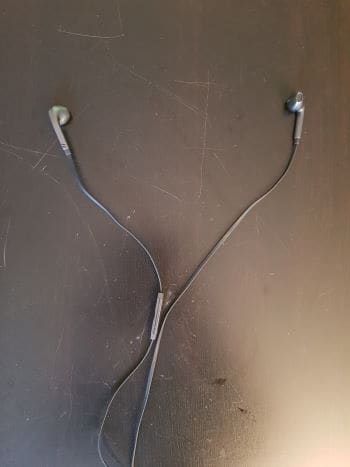
In-ear headphones are headphones that fit inside your ear. These kinds of headphones are extremely popular due to their versatility, portability, and convenience. In-ear headphones are small, light, and easy to transport from one place to another, and are often used for those who are traveling or working out but can be used in almost any situation that does not require semi-pro or professional-grade sound quality or sound isolation.
As technology continues to improve, in-ear headphones are getting better and better sound quality and comfort. As in-ear headphones fit inside of your ear canal, there is a decent amount of sound isolation and sound accuracy present. Many in-ear headphones sold today are designed to fit in your ear canal despite extensive movements, which is perfect for those who like to listen to music or podcasts while staying active.
Earbuds are a version of in-ear headphones that rest on your outer ear, right on top of your inner-ear canal opening. Since earbuds are not inserted into your ear canal, there is much more sound leakage, which is preferred in instances where you want to be able to hear more of your external surroundings.
In-ear headphones are the smallest, lightest, and most versatile kind of headphones, which is best for those who want to listen to music while exercising, traveling, or doing something that involves a lot of movement.
Essential Characteristics to Consider
Below we will go over the seven most essential aspects of a pair of headphones for you to consider. Most of these will only apply to over-ear and on-ear headphones, so if you are looking to find out how exactly to wear in-ear headphones, feel free to skip to the next section.
Clamping Force
Clamping force refers to how much pressure a pair of headphones applies to the side of your head and ears. If the clamping force is too low, then the headphones will be loose and might start sliding off. If the clamping force is too high, the headphones will start to cause pain wherever the pressure points are over time. The ideal headphones will have an even distribution of clamping force throughout the entire region that makes contact with the ear pads. If any regions such as your temples or other soft-tissue have more pressure being applied, those regions will begin to fatigue and feel pain faster than others.
For those who wear glasses and/or have piercings, clamping force is especially important. This is because headphones with too high of a clamping force will cause your glasses, which will usually be made of a hard material like plastic, to dig into your ears, while any area where you have piercings will have heightened sensitivity to direct pressure.
If your goal is to choose a pair of headphones that will fit perfectly, we would recommend that you try wearing the headphones before purchasing them. Optimally, you should try wearing a pair of headphones for 30 minutes or more before making a decision. By that point, you will have had a chance to feel the full effect of the clamping force and thus determine if you feel any discomfort from it.
Similarly to what happens when you buy a new pair of jeans or shoes, headphones might require some time to “break-in.” Coming straight from the box, the materials that make up your headphones might be a bit stiff, so it would never hurt to try stretching out the headphones a bit by placing them on something slightly larger than the size of your head.
The Headband
The headband is an essential component of your over-ear or on-ear headphones, as the headband is what rests directly on top of your head, which is right against your skull. On lighter headphones, the padding of the headband won’t matter as much, since there is not enough weight to weigh the headphones down into the top of your head. On heavier and larger over-ear headphones, however, the headband is essential.
As clamping force increases, the need for additional padding on the headband decreases, since less weight will be pushing straight down onto your head. As clamping force decreases – which might be preferred for those who wear glasses, have piercings or are more sensitive to pressure – the need for additional padding on the headband increases.
The most essential thing to consider with a headphones’ headband is the material that it is made of. Most headphones have some kind of foam underneath a nylon mesh, polyester fabric, or real/synthetic leather. Some headphones, however, do not have any additional padding or support on their headbands. A step up from standard foam would be headphones that line their headbands with a layer of silicone or leather-wrapped elastic below the metal band, allowing for soft contact with the head and structural support simultaneously.
Generally, it’s always safe to assume that the more foam or padding present on a headphones’ headband, the better it will feel resting on top of your head.
Ear Cup Extension
Since most headphones only come in one size, the ear cup extension is essential to ensuring that you can get them to fit the exact right way. Having an adjustable ear cup extension is important for both on-ear and over-ear headphones.
For on-ear headphones, if the cups are too short and do not reach down far enough, your ears will end up being pressed against your head. This constant pressure on regions with soft tissue will cause soreness and pain, which is especially the case if you wear glasses since the ear cup will press the stem of your glasses into your ears.
With over-ear headphones, the goal is to have a full, comfortable seal around your ears. Over-ear cups with an ear cup that does not reach low enough will cause there to be a gap between the cushioning and your skin around your earlobes. If this gap is big enough, there will be sound leakage. Additionally, if the cups on over-ear headphones are too short for the size and shape of your head, you might consider stretching the headband to make it fit properly around your ears. While this might solve the issue temporarily, the additional weight from the stretched headband bearing down onto your skull will cause pain over time.
To avoid issues like this, choose headphones with adjustable ear cups so that you can center the cups directly over your ears without needing to fully extend the headband. With headphones with easy adjustment, you can slide the headband either forward or back to find the perfect position with the least pressure.
Ear Cup Rotation
For headphones to potentially provide a perfect fit, lateral rotation of the ear cup plays a huge role as well. Headphones with no ear cup rotation are fixed with no wiggle room, which means that you won’t be able to do anything if one area of the ear cushions is pushing harder against your head than another.
Since most individuals have faces that taper with different contours, having ear cups with a free range of motion both laterally and vertically provides the best comfort and a snug, even fit, since individuals can customize the exact angle and direction of the ear cups.
Some headphones with fixed ear cups can still be comfortable to wear. In most cases, however, the more rotational flexibility and freedom of movement you have for your ear cups, the more comfortable the headphones will be to wear.
Ear cup rotation allows you to adjust your ear cups laterally and vertically, providing a custom fit that will feel comfortable for prolonged periods of time.
Ear Size
Even if a pair of headphones have ear cups with great flexibility and adjustability, it won’t mean much if the ear cups are too small or too large for your ears.
With over-ear headphones, if the ear cups are too small, your ear will feel cramped, and over time even soft leather will begin to feel abrasive. If you have piercings, limited space in the ear cup will lead to even greater irritation. Over-ear headphones ear cups come in three shapes: circle, oval, and D-shaped. Even though ears are not circular, circular cups tend to be the most comfortable, as they offer plenty of space and you don’t need to angle the headphones a certain way.
Many headphones that are oval or D-shaped don’t always align perfectly with the user’s ears since their ear cups form a straight line up to the headband and most humans do not have completely vertical ears.
With on-ear headphones, the only thing to consider is how big the pads that sit on your ears will be. Larger cups will have less adjustment, but will evenly spread out the clamping force over a larger area, which could decrease pressure. Smaller pads will be easier to move around and adjust for comfort but will have a more directed clamping force.
Ear Cup Depth
The depth of your headphones’ ear cup is important to consider as well. The goal is to have a depth that is not too shallow so that your ear is not rubbing against inner hardware, but not too thick so that there is no breathing room for your ear within the ear cup.
If the ear cups of over-ear headphones are too shallow, your ears might touch or rub against the inside of your headphones, which will often be metal or plastic, covered by only a thin fabric. This can cause pain and irritation over time.
With on-ear headphones, the depth does not play a huge role, as your ear will never be at risk of rubbing against interior hardware. Generally, the thicker the cushioning/padding on on-ear headphones, the more comfortable it will be for you.
Cushioning
With over-ear headphones, more cushioning will generally be more comfortable, as it will provide more protection for your ears against inner hardware. However, you don’t want to have too much cushion, since then the cushioning itself can squeeze your ears a bit.
For on-ear headphones, usually the more cushion you have, the comfier it will feel. It is still always important to try headphones on before purchasing since one pair of headphones with less cushion can be a better fit than one with more cushion.
The material of the cushions is important as well. Memory foam is the most common since it is flexible and breathable. Different memory foam cushions will feel different; however, due to having different densities. Less expensive headphones will have standard foam, which will provide less support and will eventually start to squash down flat.
Many headphones come with leather cushions as well. While there are pros and cons to each, memory foam will usually be preferred to leather since leather is more susceptible to becoming sticky and/or decaying over time.
Make it Comfortable: Choosing the Right Materials and Features
Since a quality pair of headphones will be something you’ll have for a long time, it’s important to pick one made of the best materials and with all of the features that you want.
For over-ear and on-ear headphones, the best materials will be light-weight plastic for the frame, and memory foam, silicon, or genuine leather for the cushion on the ear pads, with additional padding on the headband.
For in-ear headphones, the tips that fit in your ear canal will most likely be either foam, silicon, or rubber, or you can opt for an all-plastic earbud option. Opt for a pair that comes with multiple sizes for the tip. This will allow you to get a snug fit despite having an ear canal that is narrower or wider than the average.
Some important features to consider are volume adjustment, a pause/play button, wireless vs. wired, and adjustability. Opting for wireless Bluetooth headphones could be more convenient in many instances, you’ll just have to remember to charge them.
What is the Correct Way to Wear Headphones?
Now that you’ve picked out the perfect pair of headphones that has everything you need to make it a perfect fit, let’s go over best practices to follow for actually wearing the different kinds of headphones.
How to Wear Over-Ear Headphones
If you have a pair of over-ear headphones, first look at the ear cups to see which one is for your left ear (marked ‘L’) and which one is for your right ear (marked ‘R’). Place the headphones on top of your head, with the left ear cup over your left ear and the right ear cup over your right ear. The headband should be directly on the top of your head in the center.
Once you are wearing the headphones, the next step is to adjust them to optimize comfort. Your ears should fit snugly inside of your ear cups, not rubbing up against either the outer cushion of the ear cup or the interior hardware. To get your ears to sit directly in the center of your ear cups, you might have to either extend or retract the earcups.
Next, you can rotate the ear cups laterally or vertically to minimize pressure in any particular region of your head or ears. If you will be doing a lot of excessive movement and don’t want the headphones to fall off, you might need to retract the ear cups, which will cause the headband to dig harder into the top of your head.
If you wear glasses, you can laterally rotate the ear cups away from the frame of your glasses so that they do not press right against it. However, this will lead to some sound leakage. Alternatively, try slightly changing the position of your glasses periodically so that the pressure does not continue to increase more and more over time.
How to Wear On-Ear Headphones
The process of wearing on-ear headphones is identical to the process of wearing over-ear headphones. The only difference is that when wearing on-ear headphones, you don’t need to make sure that the ear cup clamps around your ear perfectly, you only have to ensure that the ear cup is resting right on the center of your ear.
How to Wear In-Ear Headphones
As in-ear headphones are the most popular choice for people who travel or exercise often, it’s important to wear them in such a way so as to reduce the chance that they fall out of your ears.
Before putting in your in-ear headphones, make sure you select the right size tips. Most come with small, medium, and large options. Keep in mind that each of your ears might be a different size, so you might have to use two different size tips.
Once you’ve selected the right size tip, you’re ready to put in your in-ear headphones. Rather than hastily sticking them into your ear canal and calling it a day, gently pull on your ear’s outer rim and insert the tip into your ear canal. The earphone marked ‘L’ should go in your left ear, and the earphone marked ‘R’ should go in your right ear. Once it is in, pull down on your ear lobe with the opposite hand and push the tip further into the ear until you feel it seals. Repeat this for the other ear as well.
It turns out that even if you insert your in-ear headphones perfectly, sometimes enough movement will cause it to fall out or loosen. To address this, loop the headphones’ cable around the top of each ear. Also, you can attach stabilizers to your in-ear headphones to help wedge the ear tip into place and prevent it from moving if you move. Finally, you can always anchor the headphones’ cable to the back (or front) of your shirt using a clothing clip or magnetic cord holder. By holding the cable in place, there will be less movement of the cable and thus less momentum being transferred to the in-ear headphones.
How to Make your Headphones More Comfortable
One thing that will make your headphones more comfortable is time. Just like a pair of shoes takes time to adapt to your particular feet, your headphones will adapt to the contours of your head and ears and grow more comfortable over time.
For over-ear or on-ear headphones that feel a bit tight on your head, a great way to make them more comfortable is to stretch them out a bit. To do this, simply place the headphones over something slightly larger than the size of your head and leave them like that for a few days. After this, the headphones should feel looser, more flexible, and thus have a better fit.
If enough time has passed, however, your earpads and cushions might start wearing out or becoming flat and hard. If this is the case, then replacing your ear pads will be the best option. Also, keep in mind that rather than replacing ear pads entirely, you can always add extra padding to regions where you feel you are pressing against hard material to increase comfort.
For in-ear headphones, try experimenting with different tip materials to see which one fits the best in your ear. If you’re doing something that involved a lot of physical activity and you are sweating, this might cause the in-ear headphones to slide out of your ears. To address this, keep a dry rag or paper towels nearby and periodically wipe the sweat out from your ears.

